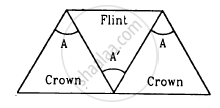Advertisements
Advertisements
Question
If three identical prisms are combined, is it possible to pass a beam that emerges undeviated? Undispersed?
Solution
No, it is not possible even when prisms are be combined with their refractive angle reversed with respect to each other. There will be at least a net deviation and dispersion equal to the dispersion and deviation produced by a single prism.
APPEARS IN
RELATED QUESTIONS
Plot a graph to show the variation of the angle of deviation as a function of the angle of incidence for light passing through a prism. Derive an expression for the refractive index of the prism in terms of angle of minimum deviation and angle of the prism.
A ray of light passes through an equilateral glass prism such that the angle of incidence is equal to the angle of emergence and each of these angles is equal to 3/4 of angle of prism. Find the angle of deviation.
What is a dispersion of light
What is the cause of dispersion of light
A ray of light incident normally on one face of a right isosceles prism is totally reflected, as shown in fig. What must be the minimum value of refractive index of glass? Give relevant calculations.

State any two difference between the primary rainbow and secondary rainbow
Give the formula that can be used to determine refractive index of materials of a prism in minimum deviation condition ?
The angular dispersion produced by a prism ___________ .
If a glass prism is dipped in water, its dispersive power ___________ .
The minimum deviations suffered by, yellow and violet beams passing through an equilateral transparent prism are 38.4°, 38.7° and 39.2° respectively. Calculate the dispersive power of the medium.
Three thin prisms are combined as shown in figure. The refractive indices of the crown glass for red, yellow and violet rays are μr, μy and μv respectively and those for the flint glass are μ'r, μ'y and μ'v respectively. Find the ratio A'/A for which (a) there is no net angular dispersion, and (b) there is no net deviation in the yellow ray.

A thin prism of crown glass (μr = 1.515, μv = 1.525) and a thin prism of flint glass (μr = 1.612, μv = 1.632) are placed in contact with each other. Their refracting angles are 5.0° each and are similarly directed. Calculate the angular dispersion produced by the combination.
Calculate dispersive power of a transparent material given : nv = 1.56, nr = 1.54, ny = 1.55.
What is meant by the dispersive power of transparent material?
How does the angle of minimum deviation of a glass prism vary if the incident violet light is replaced by red light?
Prove that in case of a prism, i + e = A + δ, where the symbols have their usual meanings.
What is meant by a thin prism?
